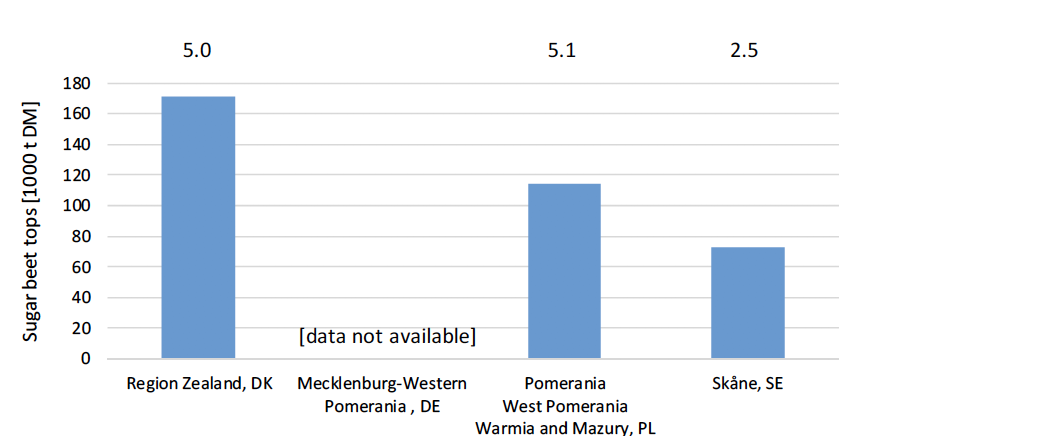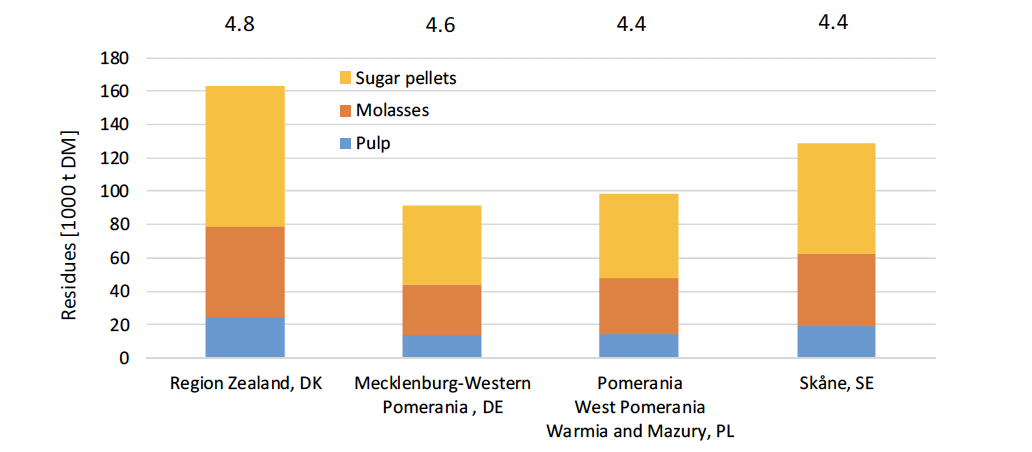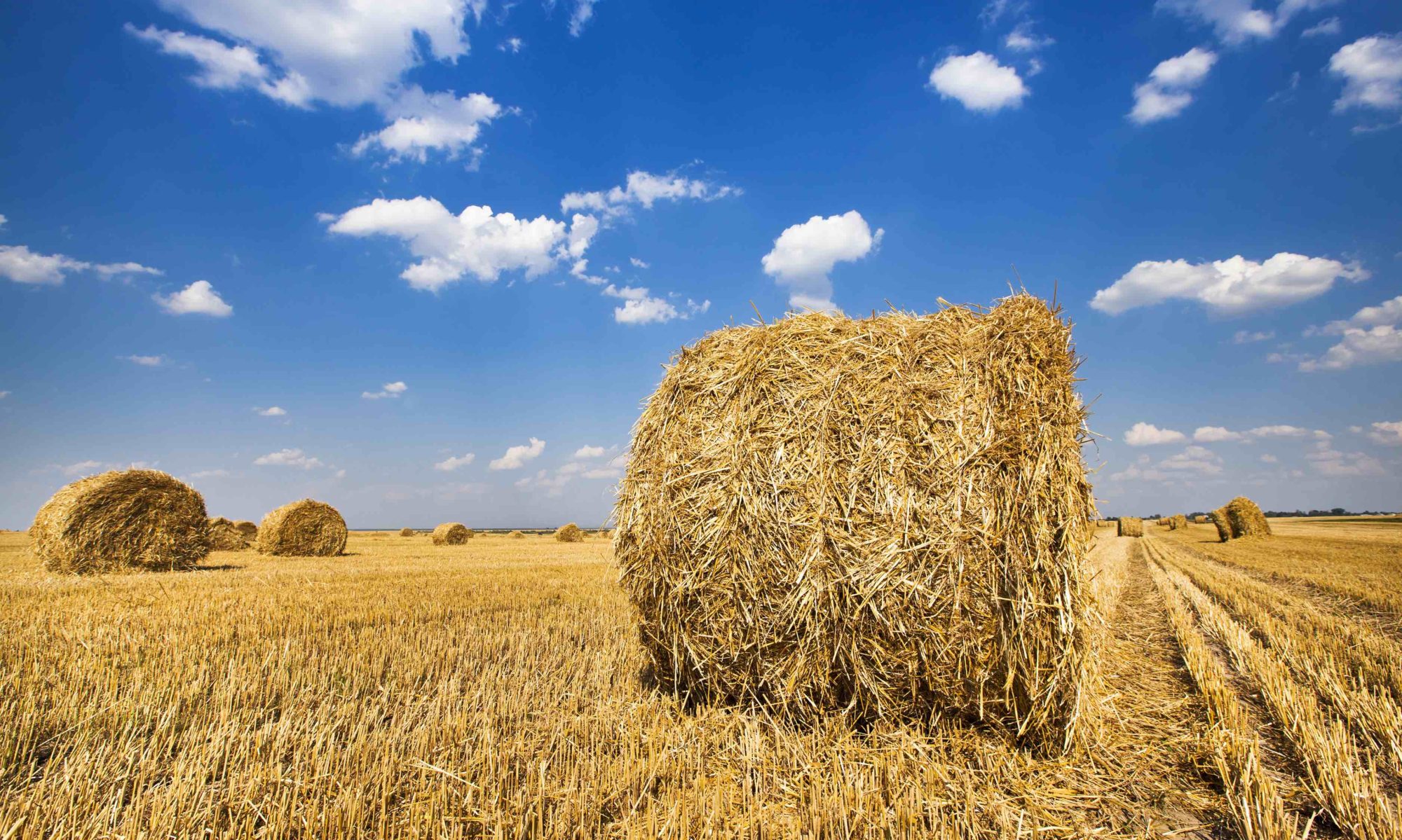The cultivation area of sugar beets in the investigated SBA regions varies between 20,000-34,000 hectares . In Poland, with a larger area of arable land, only around 1% of arable land is cultivated with sugarbeets, while Denmak and Sweden use approx. 7% of their arable land for sugar production.
 Figure 1. Cultivation area of sugarbeets in the four SBA regions. Numbers above the columns refer to the fraction of sugarbeet cultivation area on total arable land (Ref. 1).
Figure 1. Cultivation area of sugarbeets in the four SBA regions. Numbers above the columns refer to the fraction of sugarbeet cultivation area on total arable land (Ref. 1).
The amounts of sugarbeet tops available from the sugar value chain in the SBA regions varied between 73,000-171,000 tonnes dry matter annually. The differences are due to the unequal size in cultivation area between regions, but also due to the much lower (assumed) yield of sugarbeet tops per hectare, which are only half in Sweden compare to Denmark and Poland.

Figure 2. Amount of sugar beet tops [1000 t DM] in the four SBA regions. Numbers above the columns refer to the sugarbeet top dry matter yield per hectare [t DM/ha] (Ref. 2).
Other residual streams from the sugar value chain are pellets, molasses and pulp, which are present in the same relative proportions in all four SBA regions.

Figure 3. Amount of residues from sugar production [1000 t DM] in the four SBA regions. Numbers above the columns refer to the amount of residue per hectare of sugarbeet cultivation [t DM/ha] (Ref. 3).
Opportunities
The first by-product in the sugar value chain are the sugarbeet leaves or tops, which were historically used as animal feed but which are typically left in the field today and incorporated into the soils as green fertilisation. Besides energy applications such as feedstock for biogas production, sugar beet tops have been suggested – due to protein contents >25% – for protein extraction for use as food or feed. Due to higher potential revenues from protein extraction compared to use as biogas substrate, a combined protein extraction and residue digestion could outweigh the high feedstock supply costs.
Other residues include sugar pellets and molasses and pulp which can be combined to formulate attractive animal feed products. Alternative uses of residual pulp and molasses include use as feedstock for ethanol and hydrogen production through fermentation, however, it is unclear if this presents a more economic sustainable use. Residual sugar beet pulp may contain pectin substances that have do not have gel-forming capabilities as pectins extracted from citrus peel
and apple pomace, but rather have interesting emulsifying properties. Furthermore, phenolic substances were extracted from sugar beet pulp and subsequent fermetantion of the residues for production of succinic acid has been proposed.
Bottlenecks
In order to collect the sugarbeet tops in the field, add-on technology for the beeet harvesters is available, but not common. A functional chain for harvesting of tops also needs to be integrated with beet harvest, where some methods may cause additional costs due to decrease in harvesting capacity for the sugarbeets. Sugarbeet tops also have a fertilising effect that needs to be compensated for when removing the tops from the field. Sugarbeet tops usually contain only low dry matter contents (around 13%), which makes transport expensive. As a consequence, in-field fractionation units for DM recovery have been suggested.
For the residual by-products of sugar refineries, the extraction of pectins and other valuable components could be interesting and profitable, but require development of stable and cost-effective biotechnological processes.
References:
1. Prade, T., Andrzejczyk, R., M. Booker Nielsen, B. Cuypers, P. Dąbrowski, A. Ekman Nilsson, T. Kjær, J. Lund, D. Mikielewicz, M. Mittenzwei, D. Schiller, J. Wajs and M. Westkämper (2019). Biomass and innovation potential of residues, by-products and other sustainable feedstock for biobased products in four South Baltic Area regions, Interreg project Bioeconomy in the South Baltic Area: Biomass- based Innovation and Green Growth – BioBIGG. Page 114, Figure 71.
2. Prade, T., Andrzejczyk, R., M. Booker Nielsen, B. Cuypers, P. Dąbrowski, A. Ekman Nilsson, T. Kjær, J. Lund, D. Mikielewicz, M. Mittenzwei, D. Schiller, J. Wajs and M. Westkämper (2019). Biomass and innovation potential of residues, by-products and other sustainable feedstock for biobased products in four South Baltic Area regions, Interreg project Bioeconomy in the South Baltic Area: Biomass- based Innovation and Green Growth – BioBIGG. Page 114, Figure 72.
3. Prade, T., Andrzejczyk, R., M. Booker Nielsen, B. Cuypers, P. Dąbrowski, A. Ekman Nilsson, T. Kjær, J. Lund, D. Mikielewicz, M. Mittenzwei, D. Schiller, J. Wajs and M. Westkämper (2019). Biomass and innovation potential of residues, by-products and other sustainable feedstock for biobased products in four South Baltic Area regions, Interreg project Bioeconomy in the South Baltic Area: Biomass- based Innovation and Green Growth – BioBIGG. Page 115, Figure 73.
